
Concept explainers
- (a) (a.1)
Interpretation:
Number of signals expected in each of the following compounds in
Concept introduction:
The number of signals in
For each set of chemically equivalent protons, there will be one signal. For example, the
- (a) (a.1)
Answer to Problem 47P
Compound (1) will show 5 signals in its
Explanation of Solution
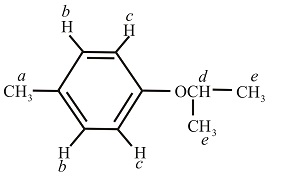
The set of chemically equivalent protons in a compound produces a separate signal in
(a.2)
Interpretation:
Number of signals expected in each of the following compounds in
Concept introduction:
The number of signals in
For each set of chemically equivalent protons, there will be one signal. For example, the
(a.2)
Answer to Problem 47P
Compound (2) will show 5 signals in its
Explanation of Solution
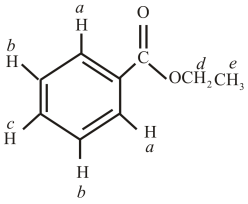
The set of chemically equivalent protons in a compound produces a separate signal in
(a.3)
Interpretation:
Number of signals expected in each of the following compounds in
Concept introduction:
The number of signals in
For each set of chemically equivalent protons, there will be one signal. For example, the
(a.3)
Answer to Problem 47P
Compound (3) will show 4 signals in its
Explanation of Solution
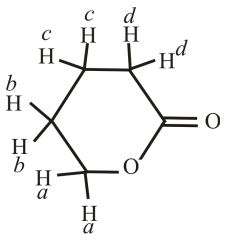
The set of chemically equivalent protons in a compound produces a separate signal in
(a.4)
Interpretation:
Number of signals expected in each of the following compounds in
Concept introduction:
The number of signals in
For each set of chemically equivalent protons, there will be one signal. For example, the
(a.4)
Answer to Problem 47P
Compound (4) will show 2 signals in its
Explanation of Solution
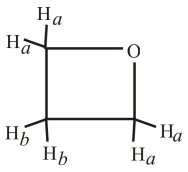
The set of chemically equivalent protons in a compound produces a separate signal in
(a.5)
Interpretation:
Number of signals expected in each of the following compounds in
Concept introduction:
The number of signals in
For each set of chemically equivalent protons, there will be one signal. For example, the
(a.5)
Answer to Problem 47P
Compound (5) will show 3 signals in its
Explanation of Solution
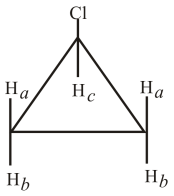
The set of chemically equivalent protons in a compound produces a separate signal in
(a.6)
Interpretation:
Number of signals expected in each of the following compounds in
Concept introduction:
The number of signals in
For each set of chemically equivalent protons, there will be one signal. For example, the
(a.6)
Answer to Problem 47P
Compound (6) will show 3 signals in its
Explanation of Solution
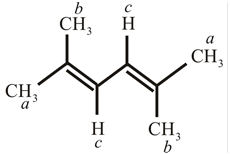
The set of chemically equivalent protons in a compound produces a separate signal in
- (b) (b.1)
Interpretation:
Number of signals expected in each of the following compounds in
Concept introduction:
The signals in the spectrum of a compound are proportional to the number of carbons that are present in the different environment within the molecule. The carbon which is present in the electron-rich environment shows a signal at a lower frequency and vice-versa. Therefore, the carbons that are present nearest to the electron-withdrawing groups produce a high-frequency signal.
- (b) (b.1)
Answer to Problem 47P
Compound (1) will show 7 signals in its
Explanation of Solution
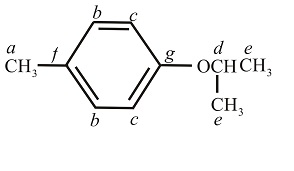
The set of chemically equivalent carbon in a compound produces a separate signal in
(b.2)
Interpretation:
Number of signals expected in each of the following compounds in
Concept introduction:
The signals in the spectrum of a compound are proportional to the number of carbons that are present in the different environment within the molecule. The carbon which is present in the electron-rich environment shows a signal at a lower frequency and vice-versa. Therefore, the carbons that are present nearest to the electron-withdrawing groups produce a high-frequency signal.
(b.2)
Answer to Problem 47P
Compound (2) will show 7 signals in its
Explanation of Solution
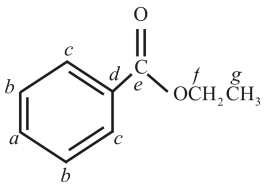
The set of chemically equivalent carbon in a compound produces a separate signal in
(b.3)
Interpretation:
Number of signals expected in each of the following compounds in
Concept introduction:
The signals in the spectrum of a compound are proportional to the number of carbons that are present in the different environment within the molecule. The carbon which is present in the electron-rich environment shows a signal at a lower frequency and vice-versa. Therefore, the carbons that are present nearest to the electron-withdrawing groups produce a high-frequency signal.
(b.3)
Answer to Problem 47P
Compound (3) will show 5 signals in its
Explanation of Solution
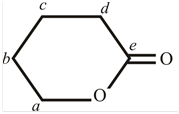
The set of chemically equivalent carbon in a compound produces a separate signal in
(b.4)
Interpretation:
Number of signals expected in each of the following compounds in
Concept introduction:
The signals in the spectrum of a compound are proportional to the number of carbons that are present in the different environment within the molecule. The carbon which is present in the electron-rich environment shows a signal at a lower frequency and vice-versa. Therefore, the carbons that are present nearest to the electron-withdrawing groups produce a high-frequency signal.
(b.4)
Answer to Problem 47P
Compound (4) will show 2 signals in its
Explanation of Solution
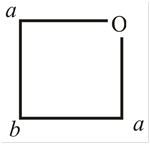
The set of chemically equivalent carbon in a compound produces a separate signal in
(b.5)
Interpretation:
Number of signals expected in each of the following compounds in
Concept introduction:
The signals in the spectrum of a compound are proportional to the number of carbons that are present in the different environment within the molecule. The carbon which is present in the electron-rich environment shows a signal at a lower frequency and vice-versa. Therefore, the carbons that are present nearest to the electron-withdrawing groups produce a high-frequency signal.
(b.5)
Answer to Problem 47P
Compound (5) will show 2 signals in its
Explanation of Solution
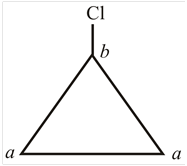
The set of chemically equivalent carbon in a compound produces a separate signal in
(b.6)
Interpretation:
Number of signals expected in each of the following compounds in
Concept introduction:
The signals in the spectrum of a compound are proportional to the number of carbons that are present in the different environment within the molecule. The carbon which is present in the electron-rich environment shows a signal at a lower frequency and vice-versa. Therefore, the carbons that are present nearest to the electron-withdrawing groups produce a high-frequency signal.
(b.6)
Answer to Problem 47P
Compound (6) will show 4 signals in its
Explanation of Solution
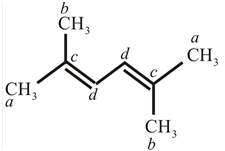
The set of chemically equivalent carbon in a compound produces a separate signal in
Want to see more full solutions like this?
Chapter 14 Solutions
CHEM 262 ORG CHEM EBOOK DIGITAL DELIVERY
- H 14. Draw the line angle form of the following molecule make sure you use the proper notation to indicate spatial positioning of atoms. F F H 15. Convert the following condensed form to line angle form: (CH3)3CCH2COCH2CON(CH2CH3)2arrow_forwardIn a reaction between two reactants A and B, the half-life is the same for both only if(A) the stoichiometry A:B is 1:1.(B) the stoichiometry A:B is 1:2 or 2:1.arrow_forwardIn a reaction between two reactants A and B, the half-life is the same for both.(1) Only if the stoichiometry A:B is 1:1.(2) If the initial quantities of A and B are in their stoichiometric ratios.arrow_forward
- There are 48 pairs of students in the following table. Each pair has quantitatively determined the mass of taurine in a 250 mL can of the popular energy drink marketed as “Munster” using High Performance Liquid Chromatography (HPLC). The class results are presented below: QUESTION: Calculate the measurement of uncertainty and provide the data in a spreadsheet table. Mass of Taurine (mg) Mass of Taurine (mg) (Table continued) 152.01 152.23 151.87 151.45 154.11 152.64 152.98 153.24 152.88 151.45 153.49 152.48 150.68 152.33 151.52 153.63 152.48 151.68 153.17 153.40 153.77 153.67 152.34 153.16 152.57 153.02 152.86 151.50 151.23 152.57 152.72 151.54 146.47 152.38 152.44 152.54 152.53 152.54 151.32 152.87 151.24 153.26 152.02 152.90 152.87 151.49 152.46 152.58arrow_forward1. Predict the organic product(s) of the following reactions. Assume excess of reagents unless otherwise noted. a) &l BH3 •THF b) 1) NaOH 2) H3O+ solve d) ala 1) EtMgBr 2) H3O+ e) H2N سكر CuLi NH2 1) SOCI2 2) EtMgBr 3) H3O+ NC H3O+ Δarrow_forwardThere are 48 pairs of students in the following table. Each pair has quantitatively determined the mass of taurine in a 250 mL can of the popular energy drink marketed as “Munster” using High Performance Liquid Chromatography (HPLC). The class results are presented below: QUESTION: Summarise and report these results including an indication of measurement uncertainty. In both calculation samples calculate if an outlier is present, max value, number of samples, mean, standard deviation, g (suspect), g (critical) and t (critical). Mass of Taurine (mg) Mass of Taurine (mg) (Table continued) 152.01 152.23 151.87 151.45 154.11 152.64 152.98 153.24 152.88 151.45 153.49 152.48 150.68 152.33 151.52 153.63 152.48 151.68 153.17 153.40 153.77 153.67 152.34 153.16 152.57 153.02 152.86 151.50 151.23 152.57 152.72 151.54 146.47 152.38 152.44 152.54 152.53 152.54 151.32…arrow_forward
- Indicate the rate expressions for reactions that have order 0, 1, and 2.arrow_forwardPROBLEMS Q1) Label the following salts as either acidic, basic, or neutral a) Fe(NOx) c) AlBr b) NH.CH COO d) HCOON (1/2 mark each) e) Fes f) NaBr Q2) What is the pH of a 0.0750 M solution of sulphuric acid?arrow_forward8. Draw all the resonance forms for each of the fling molecules or ions, and indicate the major contributor in each case, or if they are equivalent (45) (2) -PH2 سمة مدarrow_forward
- A J то گای ه +0 Also calculate the amount of starting materials chlorobenzaldehyde and p-chloroacetophenone required to prepare 400 mg of the given chalcone product 1, 3-bis(4-chlorophenyl)prop-2-en-1-one molar mass ok 1,3-bis(4-Chlorophenyl) prop-2-en-1-one = 277.1591m01 number of moles= 0.400/277.15 = 0.00144 moles 2 x 0.00 144=0.00288 moves arams of acetophenone = 0.00144 X 120.16 = 0.1739 0.1739x2=0.3469 grams of benzaldehyde = 0.00144X106.12=0.1539 0.1539x2 = 0.3069 Starting materials: 0.3469 Ox acetophenone, 0.3069 of benzaldehyde 3arrow_forward1. Answer the questions about the following reaction: (a) Draw in the arrows that can be used make this reaction occur and draw in the product of substitution in this reaction. Be sure to include any relevant stereochemistry in the product structure. + SK F Br + (b) In which solvent would this reaction proceed the fastest (Circle one) Methanol Acetone (c) Imagine that you are working for a chemical company and it was your job to perform a similar reaction to the one above, with the exception of the S atom in this reaction being replaced by an O atom. During the reaction, you observe the formation of three separate molecules instead of the single molecule obtained above. What is the likeliest other products that are formed? Draw them in the box provided.arrow_forward3. For the reactions below, draw the arrows corresponding to the transformations and draw in the boxes the reactants or products as indicated. Note: Part A should have arrows drawn going from the reactants to the middle structure and the arrows on the middle structure that would yield the final structure. For part B, you will need to draw in the reactant before being able to draw the arrows corresponding to product formation. A. B. Rearrangement ΘΗarrow_forward
 Organic ChemistryChemistryISBN:9781305580350Author:William H. Brown, Brent L. Iverson, Eric Anslyn, Christopher S. FootePublisher:Cengage Learning
Organic ChemistryChemistryISBN:9781305580350Author:William H. Brown, Brent L. Iverson, Eric Anslyn, Christopher S. FootePublisher:Cengage Learning

